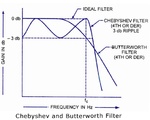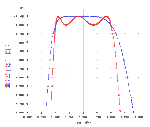desk7
Newbie level 4
I have to design a filter with the following requirements:
Type Bandpass
Nominal center frequency (F0) [GHz] 12.5 GHz
BW 2 dB [GHz] 12-13
Insertion loss @ F0 [dB] 4.5 max
Rejection band 30 dBc [GHz] [10-11.6;13.4-14.5]
Rejection band 40 dBc [GHz] [16-18]
Rejection band 60 dBc [GHz] [0.1-10;14.5-17]
Return Loss @ BW 2dB [dB] 10 min
Amplitude Ripple in any BW 25 MHz in BW 2dB ± 0.2 dB pK max
Phase Ripple in any BW 25 MHz in BW 2dB ± 2° dB pK max
Nominal impedance [Ω] 50
I can't understand the highlighted requirements because they seems inconsistent.
If 11-12 GHz is the 2dB BW how can S21 go down 4.5 dB at F0? And so on...
Could you explain me this requirements, please?
Type Bandpass
Nominal center frequency (F0) [GHz] 12.5 GHz
BW 2 dB [GHz] 12-13
Insertion loss @ F0 [dB] 4.5 max
Rejection band 30 dBc [GHz] [10-11.6;13.4-14.5]
Rejection band 40 dBc [GHz] [16-18]
Rejection band 60 dBc [GHz] [0.1-10;14.5-17]
Return Loss @ BW 2dB [dB] 10 min
Amplitude Ripple in any BW 25 MHz in BW 2dB ± 0.2 dB pK max
Phase Ripple in any BW 25 MHz in BW 2dB ± 2° dB pK max
Nominal impedance [Ω] 50
I can't understand the highlighted requirements because they seems inconsistent.
If 11-12 GHz is the 2dB BW how can S21 go down 4.5 dB at F0? And so on...
Could you explain me this requirements, please?

